From July 10 to Nov. 3, 2025, three villages on the Tuscan coast, Bolgheri, Castagneto Carducci, and Casale Marittimo, will host a multifaceted exhibition titled Widespread Art on the Tuscan Coast. The Sculptures of Joseph Bergomi, between Bolgheri, Castagneto Carducci and Casale Marittimo. The project, dedicated to Giuseppe Bergomi (Brescia, 1953) and conceived and curated by Paola Maria Formenti, brings together sixteen sculptures, mostly from private collections, along with three site-specific works created especially for the occasion. An initiative that takes the form of a diffuse art intervention, with works placed in public spaces, sacred places and historic architecture, in constant dialogue with the landscape, identity and memory of the territory. The initiative, supported by the municipalities of Castagneto Carducci and Casale Marittimo and authorized by the Curia of Massa Marittima, proposes an interpretation of contemporary art in close connection with places. The itinerary crosses a morphologically coherent area of Tuscany that transcends administrative boundaries to propose a unique cultural narrative. An area already codified in literature, from Dante to Giosuè Carducci, and today also recognized for its role in viticulture of excellence.
“After seeing so much informal, sometimes shouted art, I came to Joseph Bergomi whose figurative works brought me to a strict silence,” Paola Maria Formenti argues. “I am enchanted by the precision of execution, the scrupulous attention to technical details and his masterful execution. In front of his works, I find myself in a continuous search between formal and substantive, where present, past and future meet. With the past, I come across both the classicism of forms that always considers man at the center of the vision of art and primary source of inspiration. In the present, I see in his works games of continuous references and expectations, sometimes veiled by a slight mystery, where, however, vitality predominates. The projection into the future takes shape in a propensity toward a thought of something that must happen. This is why Joseph Bergomi pushes us toward a timeless dimension, where past, present and future interconnect. The project of a diffuse exhibition in two municipalities and three villages has the desire to open the doors to a cultural tourism in addition to the already present and established wine and food tourism.”
The selection of works privileges the link between plastic form and body memory, one of the central themes in Bergomi’s research. His sculpture, anchored in a solid knowledge of classical tradition but expressed with contemporary sensitivity, confronts architecture and open spaces, creating a site-specific aesthetic experience. In Castagneto Carducci, the path is developed in several stages. Three works are placed in Piazzale Belvedere: Ellipse, one of the new bronze creations, Chronography of a Body (2012, bronze, steel and polychrome) and Large Couple on Parallelepiped (1997, bronze). The three sculptures fit into the urban landscape, creating points of visual pause and reflection along the way. In Piazza della Gogna there is Cube with figures looking up (2023, bronze), while in front of the City Hall, in Via Vittorio Emanuele, there is another of the new works: Descriptive Geometries 3, made of corten, bronze and iron, composed of two figures, one sitting and one standing, in a game of spatial balances. The relationship between the figures, suspended between abstraction and physical tension, opens up multiple readings. Inside Palazzo Espinassi Moratti, in an underground room of medieval architecture, is Africa with Cello, a life-size bronze sculpture that the artist presented at the 2011 Venice Biennale. The work is accompanied by a dozen small figures on the same theme, all focusing on the human body and its metamorphoses.
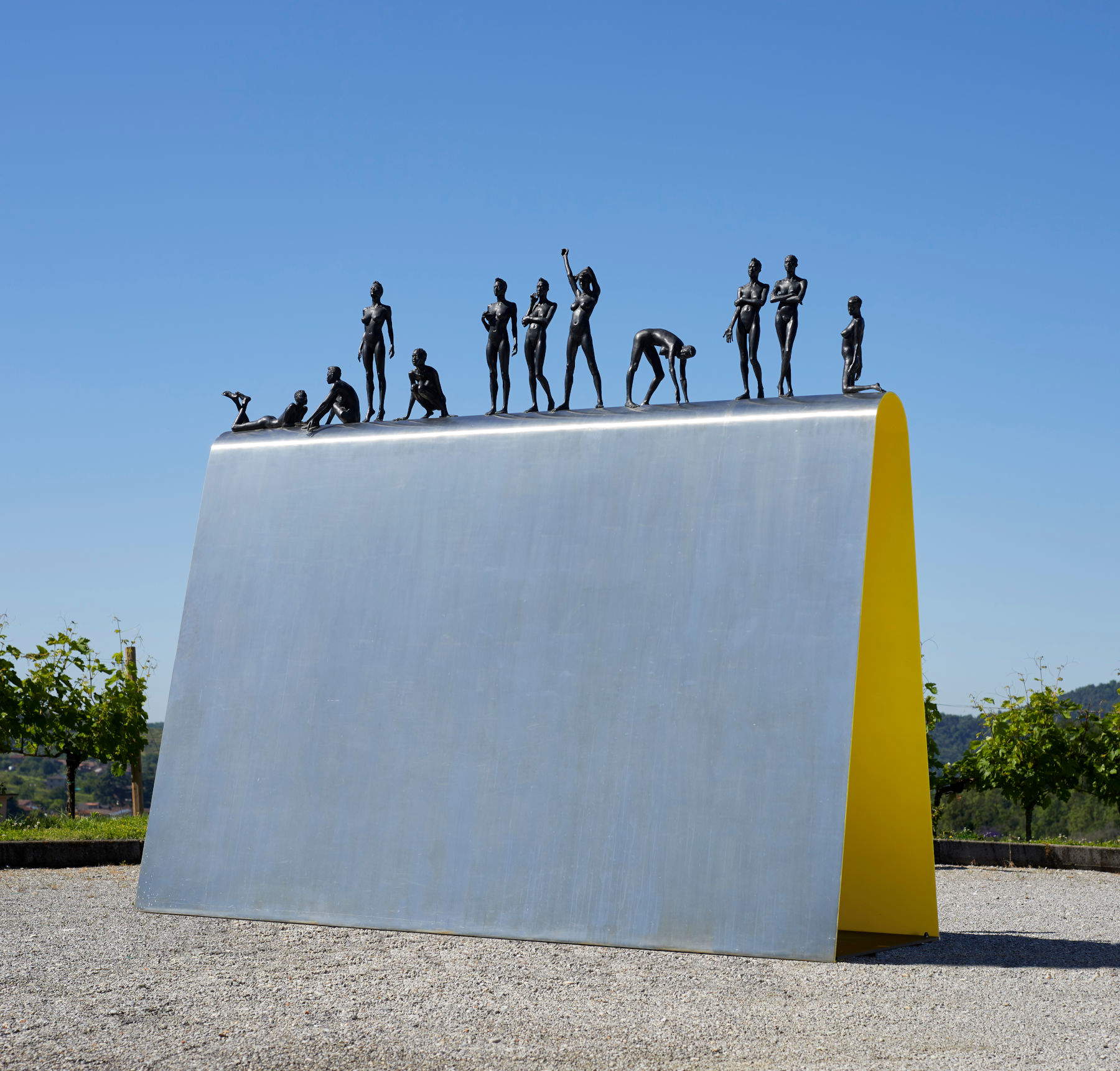
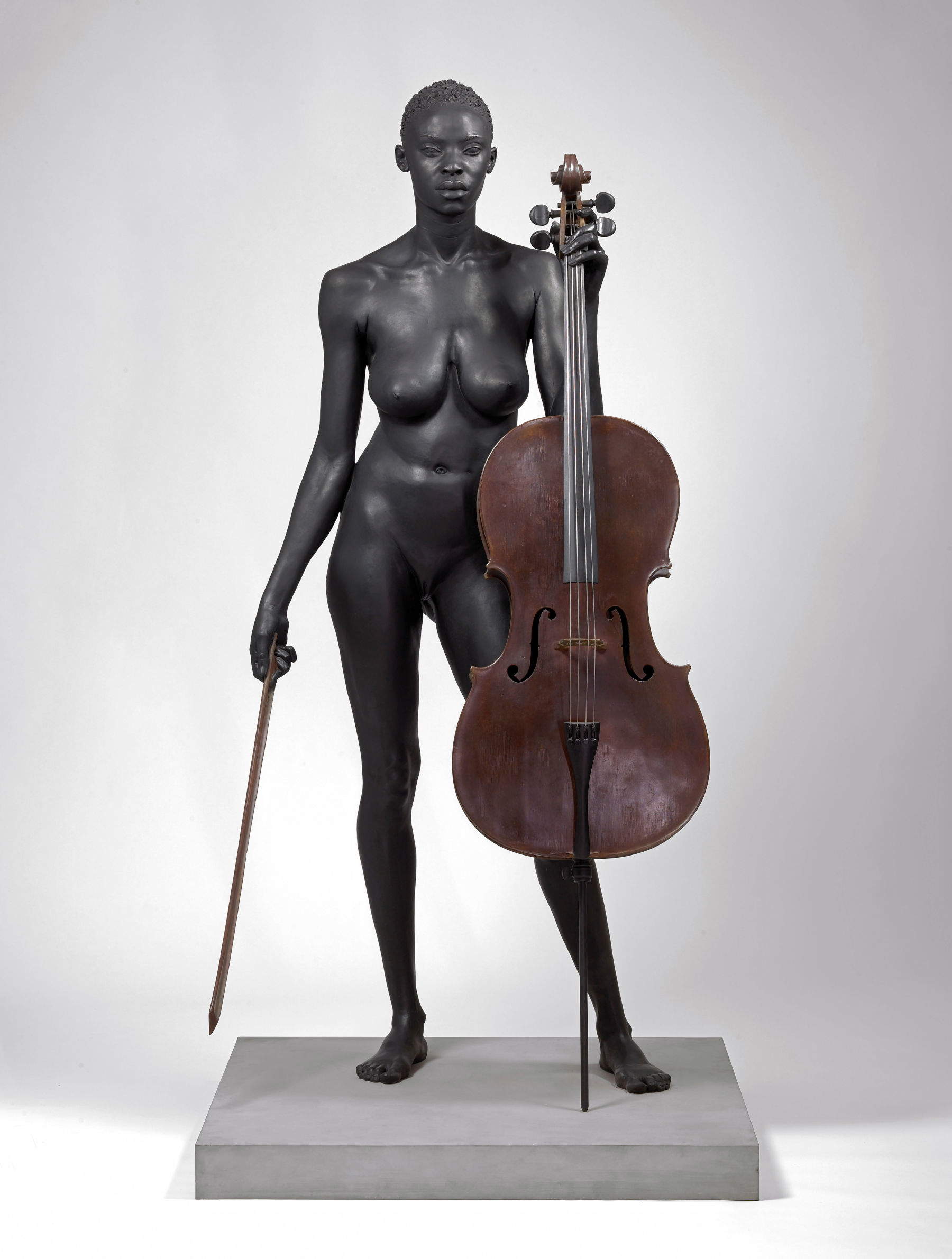
In Bolgheri, the presence of art is concentrated on the churchyard within the village walls. Here Bergomi’s third new site-specific work is installed: Stele with annunciation, in corten steel and bronze. The front of the work houses a high relief with the annunciation, while the back depicts a small Golgotha, suggesting a dual narrative and symbolic significance.
Casale Marittimo, a medieval village overlooking the Cecina Valley, represents the third stop in the project. In the Rectory, located on Via del Castello, two works are encountered: Ilaria and Valentina and Cube with Figures. On the other hand, the Oratory of San Sebastiano, in Piazza del Popolo, hosts Breakfast in Bed (2024), a composition depicting the artist with his wife, daughters and grandchildren. The work is presented as a monumental raft and takes on the value of an intimate and collective tribute to the generations of the Bergomi family. A kind of domestic mausoleum, suspended between biography and universality. Finally, the itinerary closes at the Coppaio, on Via della Ferrana, where Piccola coppia on parallelepiped stands out against a panoramic square, between sky, hills and sea.
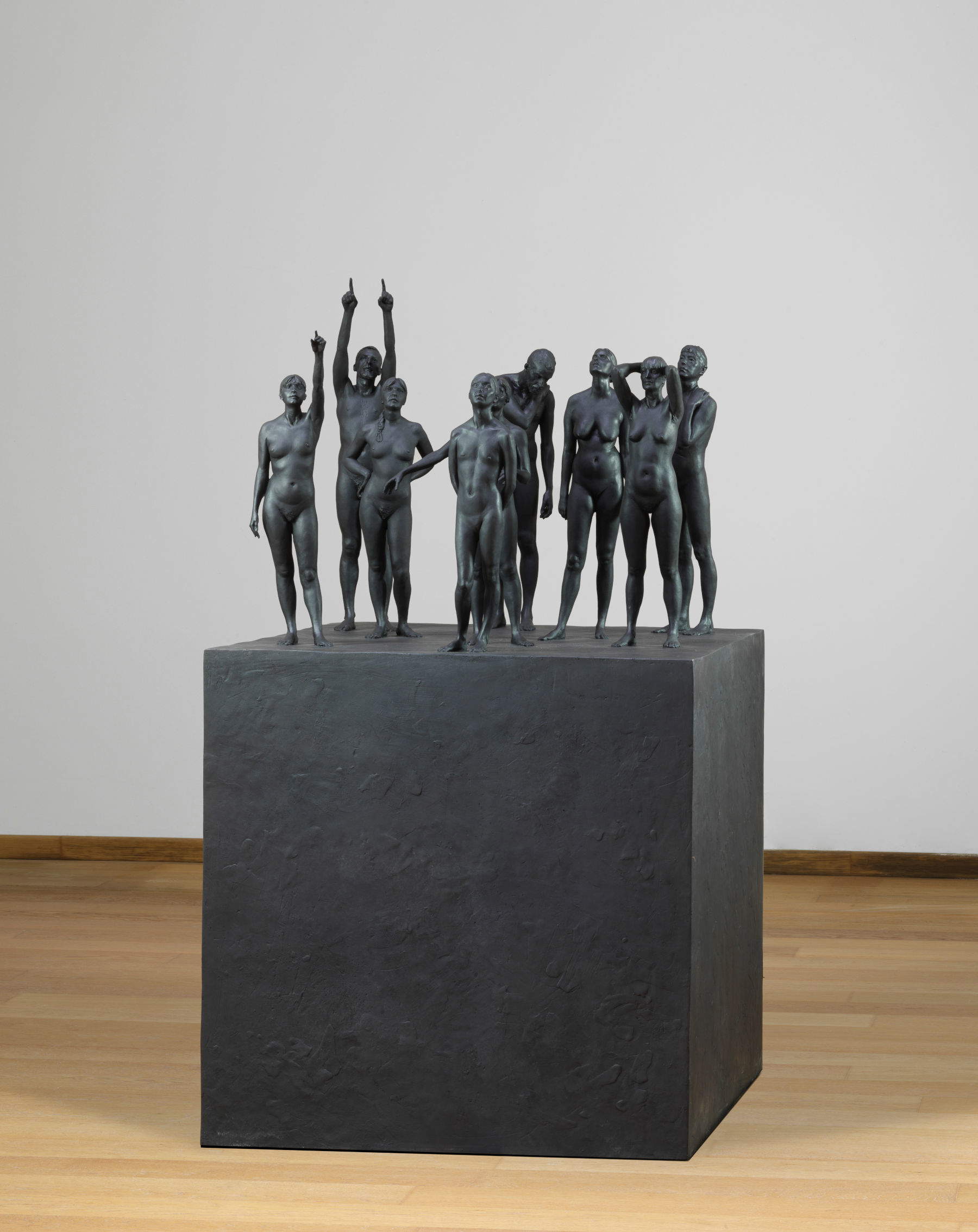

The entire project aims to solicit an active interaction between work and context, between art and everyday experience. In each of the locations, the sculptures are not imposed on the space, but fit in discreetly, modifying the viewer’s gaze without altering the identity of the place. The plurality of languages used, bronze, corten steel, iron, thus contributes to creating an expressive variety that reflects the different souls of the host territory.
Joseph Bergomi was born in Brescia in 1953. After attending the Brera Academy of Fine Arts, he made his debut as a painter in 1978 with a solo exhibition in his city. Three years later he approached sculpture, presenting his plastic works for the first time at the Galleria dell’Incisione in Brescia. From that moment he began an exhibition path that would lead him to collaborate with leading galleries, both Italian and international, receiving praise from the most authoritative critics. In 1992 Jean Clair invited him to the Prize of the International Center of Contemporary Art Chateau Beychevelle. There he made a large terracotta inspired by the allegory of Justice, a work with which he won the 1993 Grand Prix Chateau Beychevelle. Two years later the Pinacoteca di Arte Sacra Contemporanea in Loreto entrusted him with the realization of The Translation of the Hut. In 1996 he participated in the 12th Quadriennale d’Arte in Rome, an occasion when the Chamber of Deputies acquired one of his sculptures. The following year he received the Camera dei Deputati Prize and inaugurated a solo exhibition at Palazzo Montecitorio. In the same period, the Principality of Monaco purchases two of his works exhibited at the 6th Biennial of Sculpture in Monte Carlo. In 2000 he completed Men, Dolphins and Parallelepipeds, a monumental bronze sculpture placed at the entrance to the aquarium in Nagoya, Japan. In 2005 the Chiostro del Bramante hosted a major retrospective curated by Italian Factory, which was later also installed at Palazzo Martinengo in Brescia in February 2006. In 2009 he made the entire liturgical apparatus for the hospital chapel in Vimercate: altar, tabernacle, ambo, crucifix and the statue of the Blessed Virgin Mary. Numerous exhibitions from 1978 to the present, including Italiana (Shanghai Art Museum, 2007), the 54th Venice Biennale (2011, Arsenale), the Festival dei Due Mondi di Spoleto (2011), and the exhibition at Sant’Agostino di Pietrasanta (2012), in the same year in which he created two stucco sculptures depicting St. Catherine of Siena and St. John the Evangelist for the Cathedral of Noto, as part of the restoration supported by UNESCO.
In 2015 he presented Grande Ellisse, a monumental sculpture for the exhibition Treasures of Italy at the Milan Expo. The following year the Palazzo della Cultura in Catania hosts a selection of his most recent works. In 2017 he models a large terracotta angel for the Sgarbi family tomb in Stienta, in the province of Ferrara. In 2019 he inaugurates the 20th edition of the Milanesiana at the Palazzo della Borsa in Milan with the work Chronography of a Body. In the same summer he exhibits in the Cloister of San Francesco in Pietrasanta together with Ivan Theimer and Vito Tongiani, while Galleria Bonelli presents a parallel exhibition with the same artists. In 2021 he made the statue of Princess Cristina Trivulzio di Belgioioso in Milan, placed in Piazza Belgioioso. The following year Vittorio Sgarbi includes him in three prestigious exhibitions: “Canova between Innocence and Sin” at the MART in Rovereto, “Canova and Contemporary Sculpture” at the Gipsoteca in Possagno, and “Art and Power,” in dialogue with the figure of Federico da Montefeltro, at the Ducal Palace in Urbino. In 2023, the City of Brescia commissioned him to create the work Cacciata dal Paradiso (Expulsion from Paradise), dedicated to the victims of Covid, now located in the Vantiniano monumental cemetery. Finally, in 2024 he inaugurated at the Museum of Santa Giulia - Castello, Grande Miglio, the exhibition Joseph Bergomi - Sculptures 1982-2024, sponsored by the City of Brescia and the Brescia Musei Foundation.
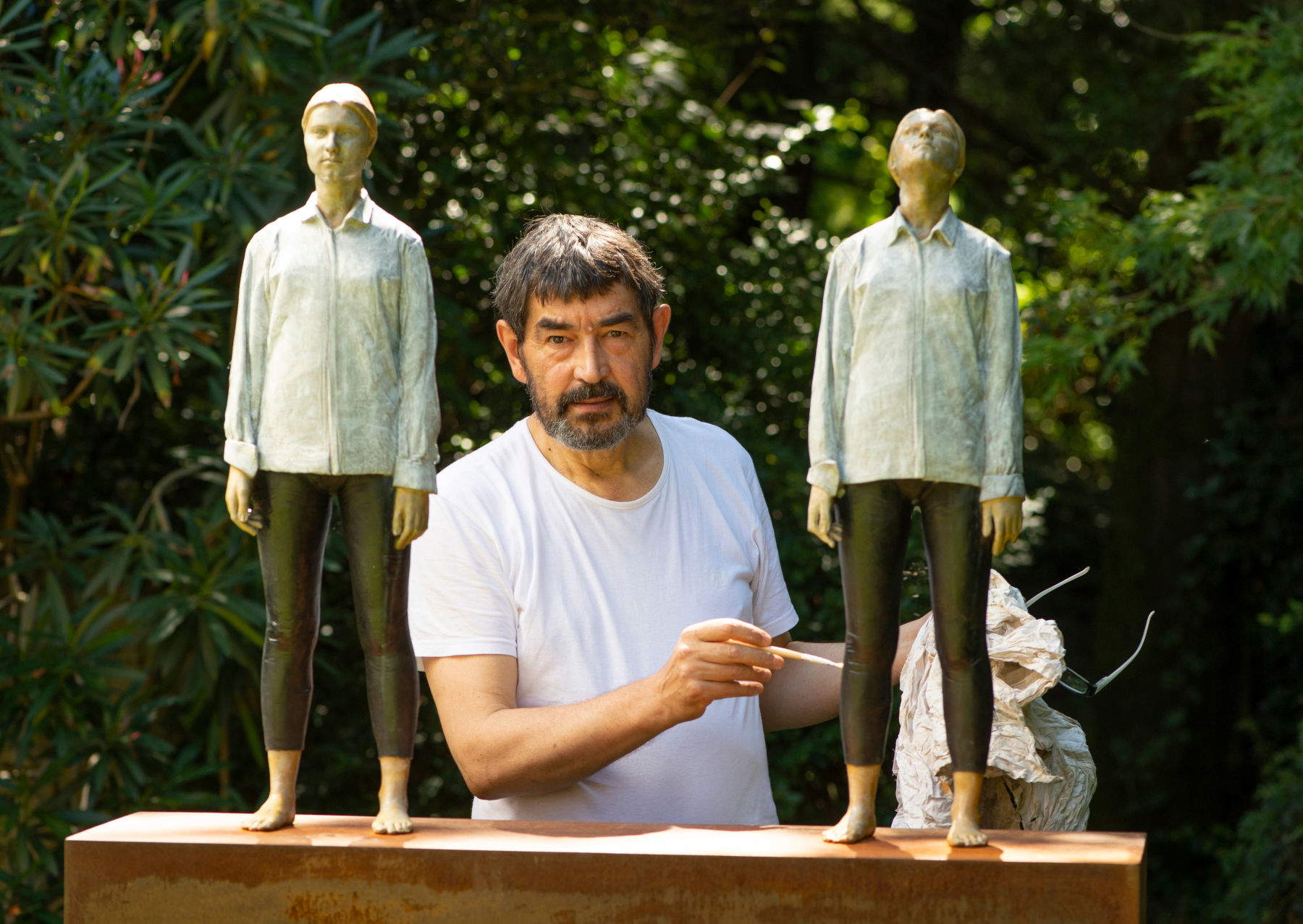
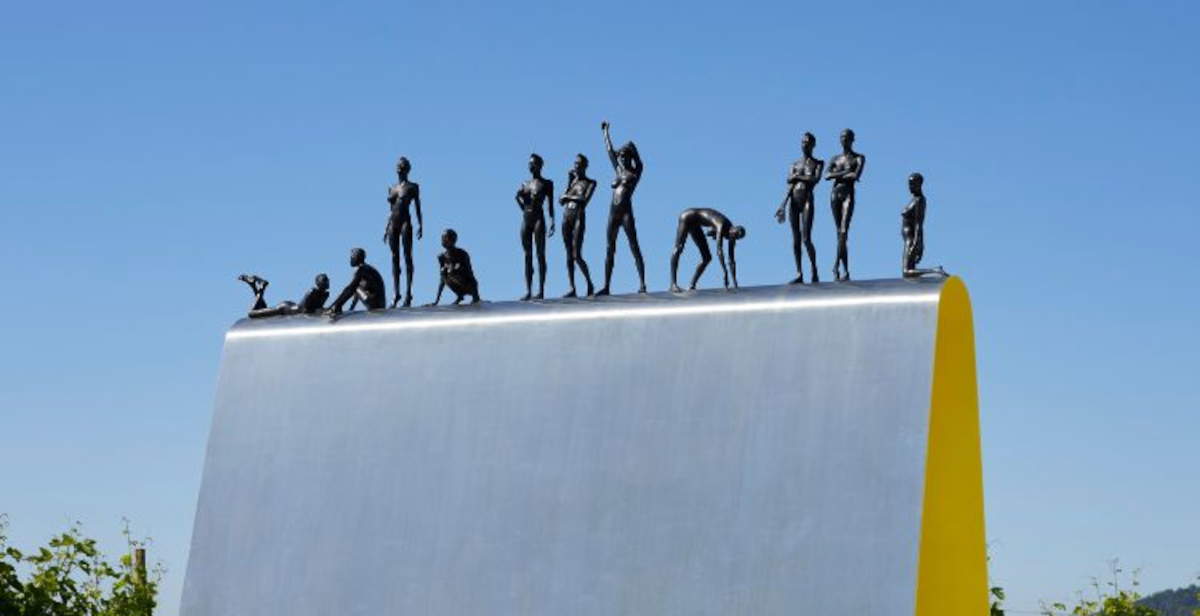 |
| Sixteen sculptures by Giuseppe Bergomi installed in Tuscan coastal villages |
Warning: the translation into English of the original Italian article was created using automatic tools. We undertake to review all articles, but we do not guarantee the total absence of inaccuracies in the translation due to the program. You can find the original by clicking on the ITA button. If you find any mistake,please contact us.